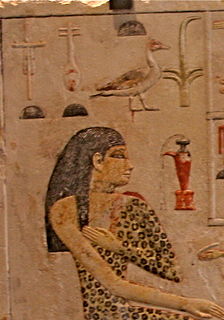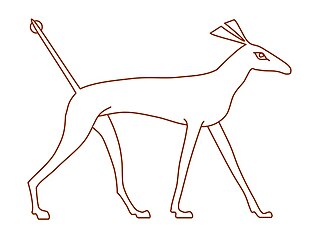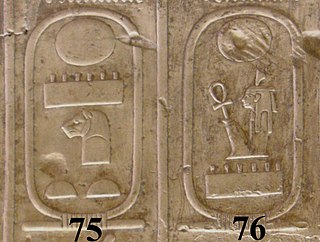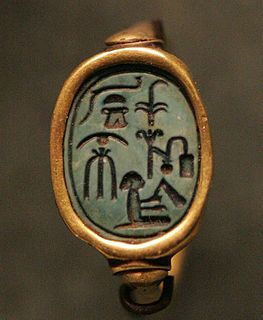
In Egyptian hieroglyphs, a cartouche is an oval with a line at one end tangent to the oval, indicating that the text enclosed is a royal name. The first examples of the cartouche are associated with pharaohs at the end of the Third Dynasty, but the feature did not come into common use until the beginning of the Fourth Dynasty under Pharaoh Sneferu. While the cartouche is usually vertical with a horizontal line, if it makes the name fit better it can be horizontal, with a vertical line at the end. The ancient Egyptian word for cartouche was shenu, and the cartouche was essentially an expanded shen ring. Demotic script reduced the cartouche to a pair of brackets and a vertical line.
Gardiner's Sign List is a list of common Egyptian hieroglyphs compiled by Sir Alan Gardiner. It is considered a standard reference in the study of ancient Egyptian hieroglyphs.

The ancient Egyptian Hill-country or "Foreign land" hieroglyph (𓈉) is a member of the sky, earth, and water hieroglyphs. A form of the hieroglyph in color, has a green line-(banding) at the base of the hieroglyph. The hieroglyph refers to the hills, and mountains, on both sides of the Nile River, and thus the green references the verdant black farming land adjacent to the river proper. It is coded N25 in Gardiner's sign list, and U+13209 in Unicode. It is determinative hieroglyph, simply conveying a meaning, and has no phonetic value.

The Egyptian hieroglyph representing gold, phonetic value nb, is important due to its use in the Horus-of-Gold name, one of the Fivefold Titulary names of the Egyptian pharaoh.

The ancient Egyptian Adze on a Wood Block, or Axe in a Block of Wood hieroglyph, Gardiner sign listed no. U20, is a portrayal of the adze. It is used mostly in the cartouches of pharaonic names especially, or other important names.

The Egyptian hieroglyph Emblem of the East is a portrayal of a standard, surmounted by the "Symbol of the East". It represents the Goddess Iabet. Her companion goddess Imentet is represented by the "Emblem of the West". As an ideogram, it represents either iꜣbt "east" or iꜣby "left". The symbol for the "West"/"right" was considered 'good', and thus the East symbol sometimes symbolized the opposite of good, evil. However, as the sun rises in the East, the solar cult often used the symbol.

The ancient Egyptian Sky hieroglyph,, is Gardiner sign listed no. N1, within the Gardiner signs for sky, earth, and water.

The ancient Egyptian Townsite-city-region (hieroglyph) is Gardiner sign listed no. O49 for the intersection of a town's streets. In some Egyptian hieroglyphs books it is called a City Plan.
The ancient Egyptian Brazier hieroglyph is Gardiner sign listed no. Q7 for the cooking brazier. It is shown from the Old Kingdom in the style of a vertical burning flame upon four feet, but the hieroglyph has the flame hiding the fourth foot. Another Gardiner unlisted form has the four feet, with no flame, and in a plan view.

The use of the Spine with fluid hieroglyph is for words showing "length", as opposed to 'breadth',. Some example words for 'length' are: to be long, length, to extend, extended; and for to expand, to dilate, words like: joy, gladness, pleasure, delight.
The Ancient Egyptian Swallow hieroglyph is Gardiner sign listed no. G36 for swallow birds. The Sparrow hieroglyph appears similar in size and shape, but it is used to represent small, or bad items.

In ancient Egyptian art, the Set animal, or sha, is the totemic animal of the god Set. Because Set was identified with the Greek Typhon, the animal is also commonly known as the Typhonian animal or Typhonic beast.
The ancient Egyptian Face hieroglyph, Gardiner sign listed no. D2 is a portrayal of the human face, frontal view.

The ancient Egyptian Pick hieroglyph, Gardiner sign listed nos. U17, U18 is a portrayal of a 'pick upon the side view of a block'; it is in the Gardiner subset for agriculture, crafts, and professions.

The ancient Egyptian Leopard head hieroglyph, Gardiner sign listed no. F9 is a portrayal of the head of a leopard; it is in the Gardiner subset for "parts of mammals".

In the Egyptian language, the single stair hieroglyph is used as a determinative.

The ancient Egyptian Water-jugs-in-stand hieroglyph, is Gardiner sign listed no. W17, W18, within the Gardiner signs for vessels of stone and earthenware.

The ancient Egyptian Scribe equipment hieroglyph 𓏞, or its reversed form 𓏟, portrays the equipment of the scribe. Numerous scribes used the hieroglyph in stating their name, either on papyrus documents, but especially on statuary or tomb reliefs.

In Egyptian hieroglyphs, the hieroglyph is used for the phonetic value of sma, with meanings of to join together, to unite with.
The ancient Egyptian Papyrus roll-tied and sealed hieroglyph comes in the common horizontal, or a vertical form. It is juxtaposed against an open scroll, the Papyrus roll-open hieroglyph,



















